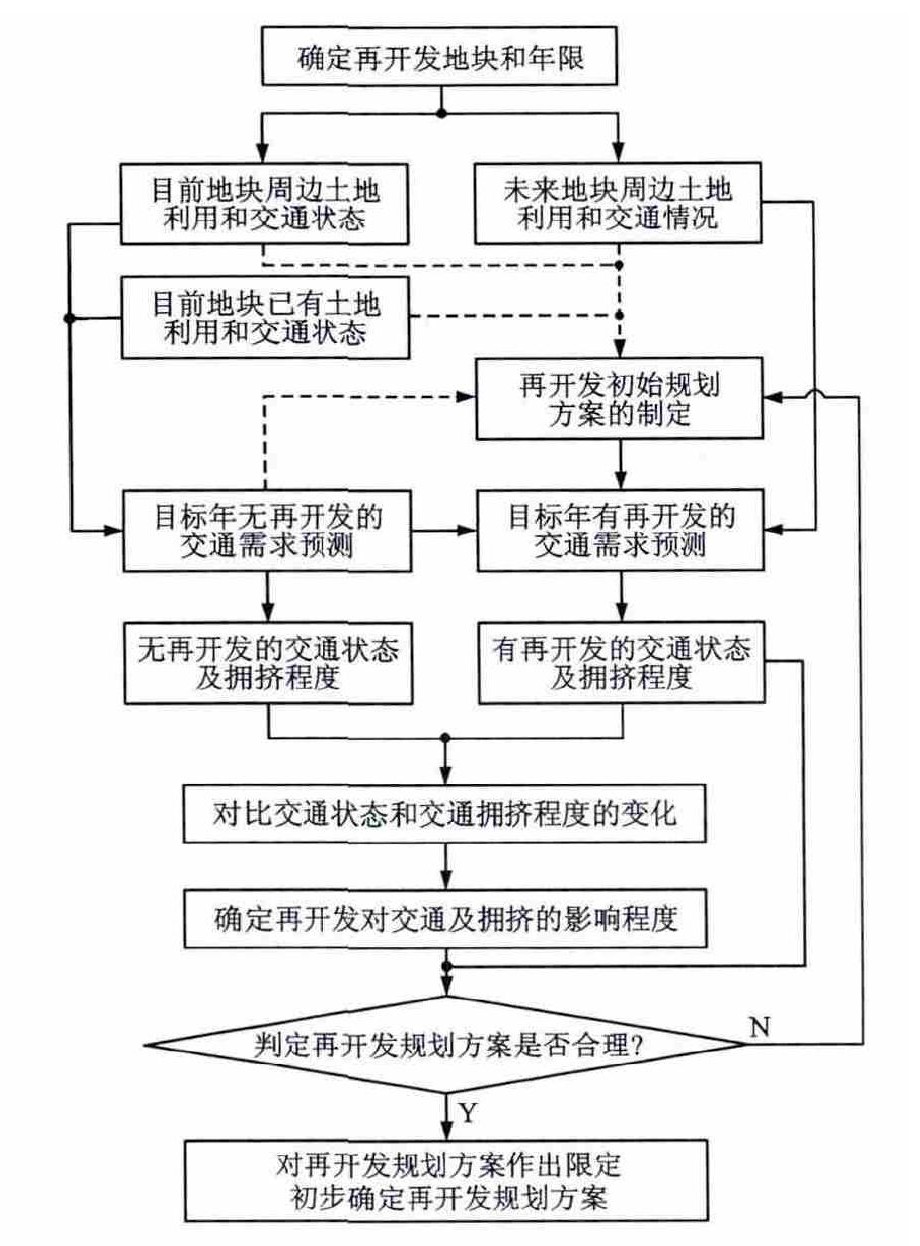Pre-examine method of traffic congestion under urban land redevelopment
-
摘要: 根据系统分析的方法, 建立了交通状态与拥挤程度评价指标体系。根据路网交通拥挤率和路网交通拥挤促成度2个指标, 评价了交通拥挤的影响程度, 确定了交通合理性的判断标准, 建立了城市用地再开发下交通拥挤预检方法, 以马里兰州部分地区的无再开发、住宅再开发、住宅与就业再开发3种方案为例进行实例验证。分析结果表明: 在第1种方案下, 小汽车分担比、平均出行距离、总行驶里程、总行驶时间、总车辆延误、拥挤车道里程、车辆延误指数和拥挤车道里程比分别为93.70%、24.98km、225 817 698km、5 369 291h、2 038 880h、4 686km、0.380、0.180;在第2种方案下, 上述指标分别为92.48%、24.78km、219 992 101veh、5 227 303h、1 831 190h、4 320km、0.350、0.166;在第3种方案下, 上述指标分别为92.22%、24.82km、219 023 166km、5 342 457h、2 062 041h、4 422km、0.386、0.169;3种方案的路网交通拥挤度分别为0.280、0.258、0.278, 但第3种方案下的车辆延误和车辆延误指数增加, 第2种方案对交通拥挤具有轻微缓解作用, 优于其他2种方案。Abstract: Based on systematic analysis method, the evaluation index system of traffic condition and congestion level was set up.Two indexes including road network traffic congestion ratio and road network traffic congestion contribution were used to evaluate the impact level of traffic congestion, the judgement standard of traffic reasonability was determined, the pre-examine method of traffic congestion under urban land redevelopment was established, and example verification was carried out by using three development schemes of partial regions in Maryland including no-redevelopment scheme, housing redevelopment scheme, housing and employment redevelopment scheme.Analysis result shows that in the first scheme, car sharing ratio, average trip distance, total running mileage, total running time, total vehicle delay, congestion lane mileage, vehicle delay index and congestion lane mileage ratio are 93.70%, 24.98 km, 225 817 698 km, 5 369 291 h, 2 038 880 h, 4 686 km, 0.380 and 0.180 respectively.In the second scheme, these indexes are 92.48%, 24.78 km, 219 992 101 km, 5 227 303 h, 1 831 190 h, 4 320 km, 0.350 and 0.166 respectively.In the third scheme, these indexes are 92.22%, 24.82 km, 219 023 166 km, 5 342 457 h, 2 062 041 h, 4 422 km, 0.386 and 0.169 respectively.The road network traffic congestion ratios of these three schemes are 0.280, 0.258, 0.278 respectively.In the third scheme, vehicle delay and vehicle delay index both rise.It is clear that the second scheme is slightly helpful to reduce traffic congestion and better than the first and third schemes.
-
Key words:
- traffic planning /
- land redevelopment /
- traffic congestion /
- pre-examine method /
- evaluation index /
- judgement standard
-
表 1 交通拥挤程度
Table 1. Traffic congestion levels

表 2 交通拥挤影响程度
Table 2. Impact levels of traffic congestion

表 3 判断标准
Table 3. Judgement standard

-
[1] GORDON D L A. Planning, design and managing change in urban waterfront redevelopment[J]. Town Planning Review, 1996, 67 (3): 261-265. doi: 10.3828/tpr.67.3.h7583x668821028u [2] WANG Yan-li, ZHU Xiao-yu, LI Lin-bo, et al. Reasons and countermeasures of traffic congestion under urban land redevelopment[J]. Procedia-Social and Behavioral Sciences, 2013, 96 (6): 2164-2172. [3] 陆化普. 城市土地利用与交通系统的一体化规划[J]. 清华大学学报: 自然科学版, 2006, 46 (9): 1499-1504. doi: 10.3321/j.issn:1000-0054.2006.09.003LU Hua-pu. Integrated planning of land-use and transportation systems[J]. Journal of Tsinghua University: Science and Technology, 2006, 46 (9): 1499-1504. (in Chinese). doi: 10.3321/j.issn:1000-0054.2006.09.003 [4] 苏海龙, 谭迎辉, 周锐, 等. 基于规划过程的我国土地使用与交通一体化规划研究展望[J]. 城市发展研究, 2013, 20 (9): 65-71. https://www.cnki.com.cn/Article/CJFDTOTAL-CSFY201309013.htmSU Hai-long, TAN Ying-hui, ZHOU Rui, et al. The prospect of China integrated planning research of land use and transportation systems based on the planning process[J]. Urban Development Studies, 2013, 20 (9): 65-71. (in Chinese). https://www.cnki.com.cn/Article/CJFDTOTAL-CSFY201309013.htm [5] 王树盛. 交通与土地利用一体化分析技术及其应用——以昆山城市总体规划为例[J]. 城市规划, 2010, 34 (增): 130-135. https://www.cnki.com.cn/Article/CJFDTOTAL-CSGH2010S1032.htmWANG Shu-sheng. Land use and transportation integrated analysis technique and its application: a case study of Kunshan master plan[J]. City Planning Review, 2010, 34 (S): 130-135. (in Chinese). https://www.cnki.com.cn/Article/CJFDTOTAL-CSGH2010S1032.htm [6] PALMA A, LINDESEY R. Traffic congestion pricing methodologies and technologies[J]. Transportation Research Part C: Emerging Technologies, 2011, 19 (6): 1377-1399. doi: 10.1016/j.trc.2011.02.010 [7] XIAO Feng, QIAN Zhen, ZHANG H M. Managing bottleneck congestion with tradable credits[J]. Transportation Research Part B: Methodological, 2013, 56 (1): 1-14. [8] TAYLOR B D. The politics of congestion mitigation[J]. Transport Policy, 2004, 11 (3): 299-302. doi: 10.1016/j.tranpol.2004.04.001 [9] BASSO L J, GUEVARA C A, GSCHWENDER A, et al. Congestion pricing, transit subsidies and dedicated bus lanes: efficient and practical solutions to congestion[J]. Transport Policy, 2011, 18 (5): 676-684. doi: 10.1016/j.tranpol.2011.01.002 [10] ANTIPOVA A, WILMOT C. Alternative approaches for reducing congestion in Baton Rouge, Louisiana[J]. Journal of Transport Geography, 2012, 24 (3): 404-410. [11] 李颖. 城市土地利用与交通系统的协同发展研究[D]. 大连: 大连海事大学, 2011.LI Ying. Study on synergic development between urban land use and transportation system[D]. Dalian: Dalian Maritime University, 2011. (in Chinese). [12] RATNER K A, GOET A R. The reshaping of land use and urban form in Denver through transit-oriented development[J]. Cities, 2013, 30 (1): 31-46. [13] HURST N B, WEST S E. Public transit and urban redevelopment: the effect of light rail transit on land use in Minneapolis, Minnesota[J]. Regional Science and Urban Economics, 2014, 46 (1): 57-72. [14] KRABBEN E, JACOBS H M. Public land development as a strategic tool for redevelopment: reflections on the Dutch experience[J]. Land Use Policy, 2013, 30 (1): 774-783. doi: 10.1016/j.landusepol.2012.06.002 [15] CHENG Fang-fang, GEERTMAN S, KUFFER M, et al. An integrative methodology to improve brownfield redevelopment planning in Chinese cities: a case study of Futian, Shenzhen[J]. Computers, Environment and Urban Systems, 2011, 35 (5): 388-398. doi: 10.1016/j.compenvurbsys.2011.05.007 [16] WANG Yan-li, ZHU Xiao-yu, LI Lin-bo, et al. Urban land redevelopment impact evaluation on non-motorized traffic: a case study in Shanghai[C]//TRB. TRB 92nd Annual Meeting Compendium of Papers. Washington DC: TRB, 2013: 1900-1923. [17] CHAPMAN J R, NOYCE D A. Influence of roadway geometric elements on driver behavior when overtaking bicycles on rural roads[J]. Journal of Traffic and Transportation Engineering: English Edition, 2014, 1 (1): 28-38. doi: 10.1016/S2095-7564(15)30086-6 [18] WANG Yan-li, ZHU Xiao-yu, LI Lin-bo, et al. Integrated multimodal metropolitan transportation model[J]. ProcediaSocial and Behavioral Sciences, 2013, 96 (6): 2138-2146. [19] GRANGE L, FERNANDEZ E, CEA J. A consolidated model of trip distribution[J]. Transportation Research Part E: Logistics and Transportation Review, 2010, 46 (1): 61-75. [20] MISHRA S, YE Xin, DUCCA F, et al. A functional integrated land use-transportation model for analyzing transportation impacts in the Maryland-Washington DC Region[J]. Sustainability: Science, Practice, and Policy, 2011, 7 (2): 60-69. -





 下载:
下载:












